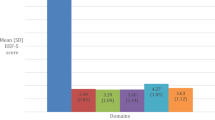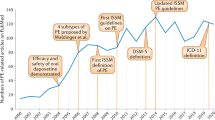Abstract
Achieving and maintaining a penile erection are two essential components of the male sexual response. It has recently been suggested that distinct molecular mechanism could underlie the two disturbances. The aim of the present study is to verify possible clinical differences on pathogenetic factors underlying difficulties of achieving and maintaining an erection. We studied a consecutive series of 560 patients (aged 51.9±12.8 y old) reporting erectile dysfunction (ED), using SIEDY© structured interview. Patients were classified into two distinct categories: those with difficulties in maintaining, rather than achieving, an erection (sample A) and those with main problems in achieving an erection (sample B). A complete physical examination and a series of metabolic, biochemical, hormonal, psychometric, penile vascular tests and nocturnal penile tumescence and rigidity evaluations (NPT) were also performed. Sample B patients showed a higher prevalence of organic conditions related to ED, when compared with sample A as confirmed by higher SIEDY© scale 1 scores (3[1–5] vs 1[0.1–3] for sample B vs sample A, respectively; P<0.0001) which explores organic component of ED and higher prevalence of pathological instrumental parameters. No difference among groups was observed for SIEDY© scale 2 (relational component) and SIEDY© scale 3 (intrapsychic component) of ED. In conclusion, this study shows for the first time that patients with difficulties in maintaining erection are less likely to be affected by organic disturbances interfering with sexual function, when compared with those unable to achieve a valid erection.
This is a preview of subscription content, access via your institution
Access options
Subscribe to this journal
Receive 8 print issues and online access
$259.00 per year
only $32.38 per issue
Buy this article
- Purchase on Springer Link
- Instant access to full article PDF
Prices may be subject to local taxes which are calculated during checkout


Similar content being viewed by others
References
NIH Consensus Development Panel on Impotence. NIH Consensus Conference: impotence. JAMA 1999; 279: 83–90.
Bivalacqua TJ et al. Endothelial dysfunction in erectile dysfunction: role of the endothelium in erectile physiology and disease. J Androl 2003; 24: S17–S37.
Burnett AL . Novel nitric oxide signaling mechanisms regulate the erectile response. Int J Impot Res 2004; 16: S15–S19.
Maggi M et al. Erectile dysfunction: from biochemical pharmacology to advances in medical therapy. Eur J Endocrinol 2000; 143: 143–154.
Petrone L et al. Structured interview on erectile dysfunction (SIEDY©): a new, multidimensional instrument for quantification of pathogenetic issues on erectile dysfunction. Int J Impot Res 2003; 15: 210–220.
Crown S, Crisp AH . A short clinical diagnostic self-rating scale for psychoneurotic patients. The Middlesex Hospital Questionnaire (M.H.Q.). Br J Psychiatry 1966; 112: 917–923.
Waldinger MD, Hengeveld MW, Zwinderman AH . An empirical operationalization study of DMS-IV diagnostic criteria for premature ejaculation. Int J Psychiatr Clin Pract 1998; 2: 287–294.
Broderick GA, Foremann MM . Iatrogenic erectile dysfunction: pharmacological and surgical therapies that alter male sexual behaviour and erectile performance. In: Carson C, Kirby R, Goldstein I (eds). Textbook of Erectile Dysfunction. Isis Medical Media Ltd: Oxford, 1999 pp 149–168.
Alberti KG, Zimmet PZ . Definition, diagnosis and classification of diabetes mellitus and its complications. Part 1: diagnosis and classification of diabetes mellitus provisional report of a WHO consultation. Diabet Med 1998; 15: 539–553.
Frank RN . Diabetic retinopathy. N Engl J Med 2004; 350: 48–58.
American Diabetes Association. Proceedings of a consensus development conference on standardized measures in diabetic neuropathy. Diabetes Care 1992; 15: 1079–1107.
Lehmann K, John H, Kacl G, Hauri D, Gasser TC . Variable response to intracavernous prostaglandin E1 testing for erectile dysfunction. Urology 1999; 54: 539–543.
Mancini M, Bartolini M, Maggi M, Innocenti P, Forti G . The presence of arterial anatomical variations can affect the results of duplex sonographic evaluation of penile vessels in impotent patients. Urology 1996; 155: 1919–1923.
Aversa A et al. A penile pharmacotesting in diagnosing male erectile dysfunction: evidence for lack of accuracy and specificity. Int J Androl 2002; 25: 6–10.
Mancini M et al. G. Duplex ultrasound evaluation of cavernosal peak systolic velocity and waveform acceleration in the penile flaccid state: clinical significance in the assessment of the arterial supply in patients with erectile dysfunction. Int J Androl 2000; 23: 199–204.
Wilkins CJ, Sriprasad S, Sidhu PS . Colour Doppler ultrasound of the penis. Clin Radiol 2003; 58: 514–523.
Hatzichristou DG et al. Nocturnal penile tumescence and rigidity monitoring in young potent volunteers: reproducibility, evaluation criteria and the effect of sexual intercourse. J Urol 1998; 159: 1921–1926.
Ralph D, McNicholas T . UK management guidelines for erectile dysfunction. Br Med J 2000; 321: 499–503.
Lue TF . Erectile dysfunction. N Engl J Med 2000; 342: 1802–1813.
Slob AK et al. The limited practical value of color Doppler sonography in the differential diagnosis of men with erectile dysfunction. Int J Impot Res 2002; 14: 201–203.
Rosen RC et al. Quality of life, mood, and sexual function: a path analytic model of treatment effects in men with erectile dysfunction and depressive symptoms. Int J Impot Res 2004; 16: 334–340.
Latini DM et al. Longitudinal differences in disease specific quality of life in men with erectile dysfunction: results from the Exploratory Comprehensive Evaluation of Erectile Dysfunction study. J Urol 2003; 169: 1437–1442.
Aversa A et al. Androgens improve cavernous vasodilation and response to sildenafil in patients with erectile dysfunction. Clin Endocrinol (Oxford) 2003; 58: 632–638.
Shabsigh R, Kaufman JM, Steidle C, Padma-Nathan H . Randomized study of testosterone gel as adjunctive therapy to sildenafil in hypogonadal men with erectile dysfunction who do not respond to sildenafil alone. J Urol 2004; 172: 658–663.
Vickers MA, Satyanarayana R . Phosphodiesterase type 5 inhibitors for the treatment of erectile dysfunction in patients with diabetes mellitus. Int J Impot Res 2002; 14: 466–471.
Acknowledgements
We thank Angela Magini, Antonio Cilotti, Andrology Unit of the University of Florence, Marco Bartolini, Radiology Unit of the University of Florence and Valerio Chiarini and Alessandra Sforza, Endocrinology Unit of Maggiore-Bellaria Hospital, Bologna, for their helpful clinical collaboration during the course of the study. This study was partially supported by a grant from, Eli Lilly & Co, Sesto Fiorentino, Florence, Italy, and from Centro di Ricerca Trasferimento ed Alta Formazione MCIDNENT of the University of Florence.
Note: a patent is pending on the use of SIEDY©.
Author information
Authors and Affiliations
Corresponding author
Rights and permissions
About this article
Cite this article
Corona, G., Petrone, L., Mannucci, E. et al. Difficulties in achieving vs maintaining erection: organic, psychogenic and relational determinants. Int J Impot Res 17, 252–258 (2005). https://doi.org/10.1038/sj.ijir.3901298
Received:
Revised:
Accepted:
Published:
Issue Date:
DOI: https://doi.org/10.1038/sj.ijir.3901298
Keywords
This article is cited by
-
Inventories for male and female sexual dysfunctions
International Journal of Impotence Research (2006)
-
Indicazioni diagnostiche e terapeutiche nella disfunzione erettile
L'Endocrinologo (2005)



